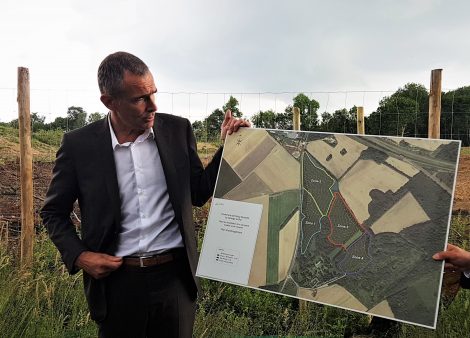SAFER IDF has officially launched the first phase of the work to rehabilitate the ‘domaine’ or estate of the château of Grange-le-Roy at Grisy-Suisnes (77). Laurent Mogno, chairman of ECT, attended to describe the phases by which inert soil will be brought to the site.
The objective of the project is to restore the domaine’s farmland with plantations of walnut trees and wood for heating, and to rehabilitate the property’s heritage and the landscaped park.
A second life for an abandoned site
Site owner SAFER IDF (Île-de- France) has acquired the 170-acre estate of Grange-le-Roy at Grisy-Suisnes in the département of Seine-et-Marne. The historical and architectural aspects are being looked after by a private investor and ECT is working on the nature and landscaping aspects.
There have been several previous failed attempts to rehabilitate the estate of Grange-le-Roy. That is why the site today shows all the signs of being derelict. The château and its outbuildings are very dilapidated, and rubbish and illegal dumping sully the ground and the natural surroundings.
Taking it back by applying a principle of ‘circular economy’: The re-use of inert soil
The provision of inert soil makes it possible to create a forestry enterprise of walnut trees and trees for fuelwood. This soil will also make it possible to restore the other natural and landscaping spaces of the estate.
How? Putting the domaine back in order in terms of forestry and landscaping is possible thanks to ECT’s upcycling of inert soil. This soil comes from construction and public works sites in the Île-de-France region, and this finances the various developments and plantations. The soil will itself be used to remodel the domaine and the park.
Renewing the landscape with a public park and productive wooded areas
At the end of the project, when it is opened to the public, walkers will be able to explore some remarkable new features:
- There will be a foundation for contemporary and digital art in the château and the park
- The 2.5 acre walking area will be enhanced by a sloping bank providing an open panorama
- The forestry will consist of a 50-acre plantation of walnut trees and 7 acres of fuelwood.
- A new meadow and open spaces will offer a haven of biodiversity
Respect for biodiversity
The project will include a number of measures to conserve ecological habitats. It’s a question of sustaining sensitive natural habitats and encouraging flora and fauna.
On the 24 acres of natural habitats there are important ecological issues, especially as regards the open spaces and the wetland zones on the site. Ecological site management will reinforce the conservation initiatives. The wetlands will be conserved over 10 acres and recreated over 1.5 acres with the installation of reed beds. ECT is restoring 7 small lakes.
There will be specific developments for protected species. With the creation and restoration of lakes, there will be bat-boxes and refuges for reptiles. ECT has relocated amphibians and a protected flower (a bladderwort, Utricularia australis).
Finally, ECT is arranging for there to be ecological follow-up of the site over a period of 30 years.
The project in numbers
- 30 years of dereliction
- 30 years of ecological follow-up
- 2019 = date when inert soil starts to arrive
- 5 years = duration of the development works
- 4,400 walnut trees planted on 50 acres
- 6,240m² of wetland

